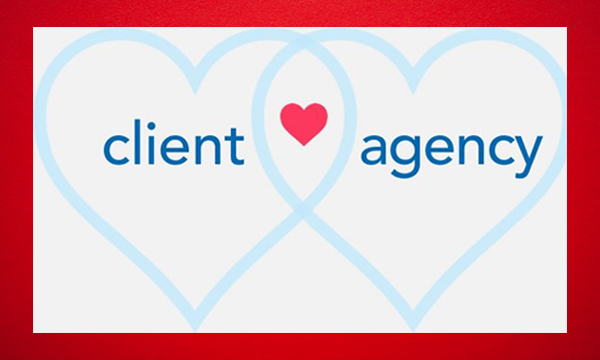Today is St. Valentine’s day. As Jay Leno is supposed to have said, “Women call it Love Day, while men name it as Extortion Day”. If we substitute “Women” by “Agencies” and “Men” by “Clients”, would we be far off the mark?
As the wag said, “you pays your money and you takes your choice”, but is that the end of the matter?
When Clients select their Agencies (sadly, not the other way round), do they both then kiss and vow to remain together, for better or for worse, until death (or falling sales) do them part? Or does the first blush of youth and love rapidly disappear because looks were deceiving, or because of a roving eye, or ennui, or any combination of these?
What better day, then, than Valentine’s, to explore the zeitgeist of the relationship between Clients and their Agencies in the world’s second oldest profession? Are there any solutions to the lament of “He doesn’t love me anymore” and the counteraccusation of “I don’t like your cooking anymore”? Can there ever be a resolution to the Seven Year Itch (in many cases now, much, much less than seven)?
There are indeed many prescriptions, ranging from the ‘granny-home’ to the ‘robustly muscular and direct’ to the (bringing up the rear) ‘professionally objective and equal’, for analyzing Client-Agency relationships, those that have stood the test of time, and those that haven’t.
Leading the way is the home/muscular-direct remedy.
As one of the fiercely mustachioed worthies of the advertising world told me many years ago, “Arre, what’s the problem, just have a beer with the client CEO/marketing head and all will be well, why do we need a system to tell us about our relationship?” If it were indeed so easy, why hasn’t this magic recipe been institutionalized and held up as best practice in a sector that is rife with pitches and agency changes?
The reason is that no relationship, especially a commercial, working relationship that encompasses many people of different skills, predilections, and views on both sides, can be maintained on a diet of senior beers. I dare say neither could a personal one consisting of two people!
But we are like that only! We love the easy way out, but if there is one thing that all of us Indians will agree on, is that diligent, professional, objective and regular analysis and follow-up is not what we’re good at, because that means being disciplined, and discipline is not something we take well to, witness our traffic, public hygiene, civic sense, and affinity for jugaad.
Recently a worthy of the marketing fraternity unveiled a ‘Technique’ based on the “Three T’s” (Time, Talk and Trust), identified by him as the ingredients of the magic potion which, he said, if imbibed conscientiously, would help to make love bloom forever in the thorny thickets of the marketing-advertising jungle.
All good so far, and a nice catchy alliterative slogan to boot. But the devil’s in the doing, and as Walt Disney held, “The way to get started is to quit talking and begin doing”.
So let me explain why I believe that the ‘Three T’s’ (bless them), need to be based on the hard yards of the ‘Two W’s’ (Why, When) and ‘One H’ (How) by using a metaphor of my own: a C-A relationship (actually any relationship) is like a river, some smooth passages, some rocky, some definitely dangerous, some fresh, some polluted, often with changing contours but hopefully continuously flowing, because when a river stagnates, it is dead. It is important to gauge the health of the river, then, at all times, so that bottlenecks are removed, courses corrected if needed and full advantage taken of the smooth flows when they occur. White water rafting is fun, but you don’t want to be doing it every day!
1) Why? I have advisedly used the word ‘maintained’ in the ‘senior beers’ section above. This is because unlike a marriage (to which the C-A relationship has often been – incorrectly- compared), the C-A relationship is:
a) comprised of many different personnel working at different levels and on different aspects and who, importantly, can and do keep changing over the course of time; many of them work at the real coal face, where things can get tough and dirty, unlike the pleasant confines of boardrooms; thus one person’s view, however, senior he or she may be, should not be the basis of assessing the relationship; in fact, the rot often starts below;
b) a commercial one with hard and measurable commercial objectives. (Of course, many marriages in India are based on this same principle, but that need not detain us here);
c) most importantly, just like any other relationship, ultimately dependent on the behavior and performance of both parties. It has now been proven with 99.9999 percent statistical confidence that David Ogilvy was indeed correct when he said: “Clients get the advertising they deserve”. So if you want the best outcomes from the relationship, an open and honest dialogue of feedback needs to flow in both directions.
Trust’ can only arrive if both parties believe it is a partnership of equals, with an equal voice on a level playing field. This inevitably calls for some system which can help ‘maintain’ the relationship on an even keel despite personnel churn and subjective evaluations.
2) When? A dipstick in the river (or a beer in the evening) may not (and usually does not) give us a representative picture of how it is evolving, and what is happening along its course. It is akin to the marketing process, which also needs constant and fresh information to enable successful decision-making, planning, and execution on a dynamic basis. Marketing information collection is never only annual or limited to a single report, as it would become dated and unusable. The same holds true for the C-A relationship, which is itself crucial for marketing success. So it follows that a C-A relationship should also be evaluated and information collected on a regular basis, to allow for early warning if there are rocky passages coming up, or stagnation setting in, and to ensure that benefits of the smooth passages are maximized.
3) How? Happily, such a system exists. APRAIS Worldwide (www.aprais.com) has been helping Clients and Agencies the world over to objectively monitor and measurably improve the C-A relationship across the globe, from Albania to Vietnam, for the past 17 years. APRAIS has helped assess over 16,000 relationships and the data from that vast pool has demonstrated clearly that regular, objective assessments make the C-A relationship more effective across all parameters, as is evident from the Ogilvy quote example above. Many in the marketing and advertising industry are aware of this, but one assumes that running the ones and twos of regular assessments and dedicated follow-ups on the findings is perhaps not as thrilling as hitting all those glorious sixes of grand-sounding sentiments.
Many in the marketing and advertising industry are aware of this, but one assumes that running the ones and twos of regular assessments and dedicated follow-ups on the findings is perhaps not as thrilling as hitting all those glorious sixes of grand-sounding sentiments.
However, if the C-A relationship is the subject of so many discussions, so much sound and fury and so many ups-and-downs, then surely objective and regular assessments could help ensure they remain happy and healthy. Alas, despite protestations to the contrary this seems not to have happened in India, or otherwise, why should we coin pithy slogans even today?
And so let me end with Three Q’s (Quotes!) to supplement the Three T’s and put the entire C-A relationship matter into perspective.
As Fred Allen (famous American radio show host & comedian) said, “It is probably not love that makes the world go around, but rather those mutually supportive alliances through which partners recognize their dependence on each other for the achievement of shared and private goals.”
And as Robert Heinlein (famous Sci-fi author) said, “Love is the condition in which the happiness of another person is essential to your own.” And finally, as Eva Gabor (and she should know) so pithily put it, “Love is a game that two can play and both win.”
The post first appeared on CampaignIndia.com







































